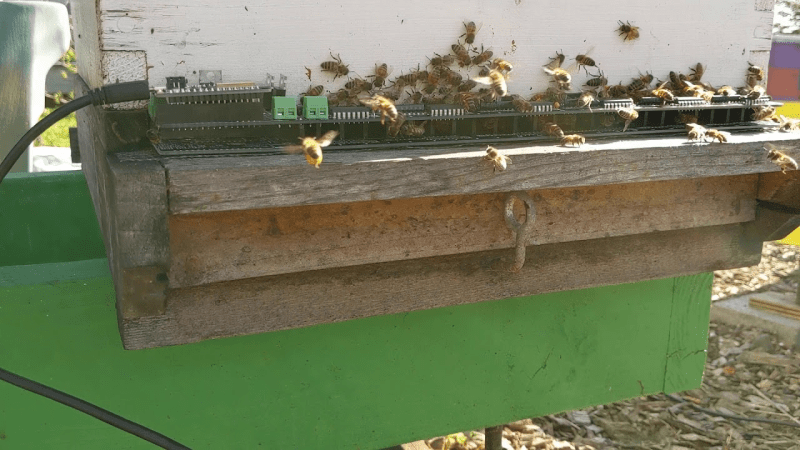While we admit that free honey sounds pretty good, beekeeping is not some set-it-and-forget-it hobby where you can just put bees in a box and come back in a month to collect the goods. With the world’s bee population in decline, it’s more important than ever to monitor the health of hives.
One way to do that is to count the bees as they leave and reenter the hive. You can use the data to determine how many workers are working, or to compare activity between multiple hives. If you notice the bees are gone for longer and longer periods, it’s probably because their nearby nectar sources are dwindling and they have to travel farther to find flowers.
This open-source bee counter built by [hydronics2] is designed to fit the opening of a standard hive. The bees can only buzz themselves back in by flying through one of 24 little IR break-beam gates. Our favorite thing about this build is the way [hydronics2] created the individual gates by sandwiching two boards together with headers as spacers. It’s such a simple and perfect solution.
It’s also pretty cool that the board is designed to be compatible with any Feather or ItsyBitsy board, so there are a lot of options for data handling. Check out the brief demo we planted after the break, and stick around for the build video. If you’d prefer a more hands-off approach, try computer vision.
[via Instructables]















It would be interesting to recognise each bee. Presumably they are all different like humans and every other animal I can think of.
As long as you’re not in Europe. Bees never agree to those clickthrough GDPR disclaimers.
Not easy, they are all twins, or thousands, whatever, mostly identical.
Not exactly. Each drone from a given queen is a haploid son of the queen, but has some mix of genes from each of the queen’s parents. Each daughter is a diploid daughter of the queen and one of the (10-50) drones she mated with during her mating flights. Many daughters (workers) are sisters, but most are effectively half-sisters (same mother, different father).
Will the sensors get dirty and stop working?
I would think the passage of the Bee will ‘clean’ the system pretty well. Time will tell – if it does stop working its not hard to clean with the way it is put together anyway.
I don’t see any protection for the circuit from bumps, rain etc however.. That would be a good next step for longjevity I think POT the whole thing (assuming you can do it right) I don’t think any of the clear potting compounds are IR blocker s either.
Nice project congrats
“Bee Counter Will Have You Up To Your Nectar In Hive Data” HaD’s best corn-ball headline ever. Lowest score in Groanonomy AND Groanology yet.
pun overload
I found it amusing
Next is a security line of zappers to kill wasps.
Wasps are piddley if you can make something to replace the mosquito hunters i hired TAKE MY
MONEY!
Mosquitos aren’t a particular threat to bees, are they? While wasps certainly are…
Anyone have one of these working with the data feeding to an accessible repo online?
Beekeeper here… can you share a report, data dump or chart, so we can see a sample hive’s actual I/O flight data? Charting by time of day, and temp would be interesting to see. WSU has done some recent studies where they used RFI’s attached to individual Bees and GPS tracked foraging distances and patterns (time per return trip, miles travelled, etc.). Fascinating!